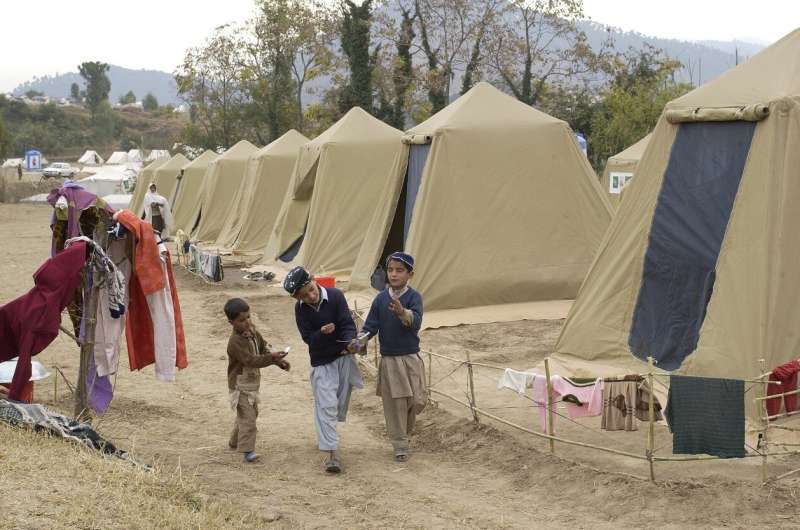
Refugees are providing energy within camps home to millions of displaced people around the world, my research has found.
There are now more than 120 million forcibly displaced people globally. Although United Nations humanitarian agencies provide firewood and small electric lanterns, these are often not enough for most families.
To make up the shortfall, entrepreneurial refugees in the camps I visited have become energy suppliers by establishing shops, phone charging stations, even cinemas.
While visiting camps administered by the UN Refugee Agency in Rwanda, Kenya, the Democratic Republic of the Congo, Somalia, Sudan, Uganda and other countries across Africa, I was struck by the hum of electricity and the smell of cooking in the camps’ markets. Energy was everywhere.
In all the camps I visited, people were selling clothes, cooking bowls and toys, as well as lighting and electrical appliances. These shops all used energy—computers totted up bills and printed receipts, radios played music, and people everywhere were using mobile phones and the internet. Fans and motors were working hard to keep things cool and the power on. Refugees buy these products at local markets—which are often run by refugees themselves.
After conducting more than 170 interviews with refugees and humanitarian practitioners, it became clear refugees buy their own energy to run many of these cafes and shops: buying their own diesel, generators, or electricity technologies including solar panels and batteries.
Formal refugee energy access provided by humanitarian agencies or national governments is projected to be very low: Chatham House statistics suggest 94% of forcibly displaced people living in camps have no meaningful access to power, and 81% lack anything other than the most basic fuels for cooking.
Renewable connections
Local energy businesses operating around the camps in Rwanda and Kenya, such as BBOX or MESH Power, provide solar solutions, such as selling solar panels and solar home systems from which refugees can have lighting, charge their phones and plug in electrical appliances. These renewable systems help to lower the costs—but sometimes the companies are not able to expand their businesses within refugee camps due to UN restrictions.
As one of the refugees I spoke to in Rwanda explained: “You can see two types of solar business really. Those using energy that is easy to get to—off-the-shelf products and services—to keep the lights on in the night, or offer cool drinks or a fan. And those businesses where really energy is the business … where people can use solar home systems or other technologies.”
Sadly, this picture is not uniform across the world. For example, buying diesel in refugee camps or purchasing kerosene for lanterns can be very expensive. Spending by displaced people on simple cooking fuels and technologies, as well as basic lighting, is estimated to be around US$200 (£160) per year per family, for less than four hours of energy a day.
Buying from external energy suppliers often comes at great cost to refugee families as energy in refugee camps can be incredibly expensive. Estimates suggest that refugee households in Kenya and Burkina Faso spend between 15% and 30% of their income on energy—a figure that in the UK would mean a household was in a situation of extreme fuel poverty.
In total, refugee households around the world spend at least US$2.1 billion (£1.68 billion) on energy each year.
Refugee-led businesses
In the face of such challenges, refugee energy entrepreneurs are expanding the range of energy services and products available to refugee communities in terms of sustainability: providing new solar solutions and electricity connections from solar-powered energy sources. For members of the refugee community who use this service, this can reduce the cost of energy.
These refugee-led enterprises often start after refugees have saved or borrowed money from friends and family to start their energy businesses—for example, by buying a solar panel and battery and charging customers to use the electricity it generates. Sometimes referred to as micro-enterprises or energy entrepreneurs, they go beyond being passive users of electricity and become active participants in the energy economies of refugee camps.
Examples of such businesses include Kakuma Ventures, based in Kakuma refugee camp in Kenya, which provides wifi and solar energy access to more than 1,500 people in the camps.
Another example is Patapia, based in camps in Uganda, which helps refugee women launch and grow businesses powered by clean energy. Successful refugee-led energy businesses are highlighted by the work of climate change charity Ashden through its Humanitarian Energy Award, and its support for local businesses leading the way on sustainable energy in humanitarian settings.
Indeed, many new global initiatives and humanitarian programs are starting to take seriously the role of refugee-led organizations and businesses. Take the work of Last Mile Climate, which is dedicated to helping grassroots initiatives, refugee-led businesses, charities, humanitarian agencies and government organizations tackle climate-related challenges.
Refugees are also writing on this issue in the media, highlighting how important the issue of inclusivity is in delivering the sustainable energy transition in humanitarian contexts.
This article is republished from The Conversation under a Creative Commons license. Read the original article.![]()
Citation:
How refugee entrepreneurs are supplying sustainable energy to the camps where they live (2025, February 20)
retrieved 20 February 2025
from
This document is subject to copyright. Apart from any fair dealing for the purpose of private study or research, no
part may be reproduced without the written permission. The content is provided for information purposes only.













Leave a comment